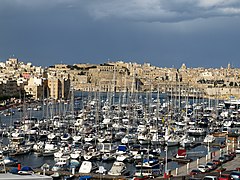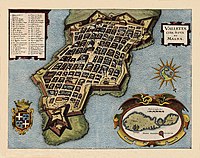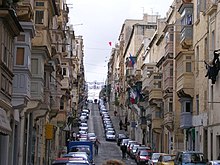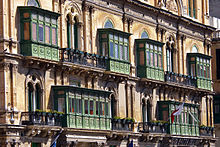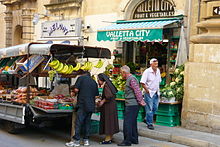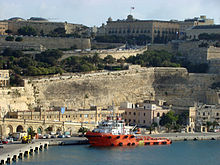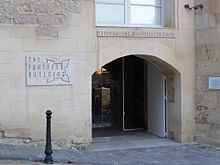Valletta
| coat of arms | map |
|---|---|

|
|
| Basic data | |
| State : | Malta |
| Area : | 0.840,981 km² |
| Residents : | 5827 (December 31, 2018) |
| Population density : | 6929 inhabitants / km² |
| ISO 3166-2 : | MT-60 |
| Postal code : | VLT |
| Website : | www.cityofvalletta.org |
| politics | |
| Mayor : | Alexiei Dingli ( NP ) |
Coordinates: 35 ° 54 ' N , 14 ° 31' E
| City of Valletta | |
|---|---|
|
UNESCO world heritage |
|

|
|
| Contracting State (s): |
|
| Type: | Culture |
| Criteria : | (i) (vi) |
| Area: | 55.5 ha |
| Reference No .: | 131 |
| UNESCO region : | Europe and North America |
| History of enrollment | |
| Enrollment: | 1980 ( session 4 ) |
Valletta ( Maltese also il-Belt Valletta , il-Belt Valetta , Valetta or il-Belt - Italian also La Valletta ) is the capital of the Republic of Malta . It is the smallest capital of an EU state in terms of both area and population . Due to its cultural richness, Valletta was inscribed on the UNESCO World Heritage List in 1980 as a total monument. In 2018 Valletta was European Capital of Culture together with Leeuwarden (NL) .
Valletta is one of the best historically secured cities in the world because it is surrounded by a ring of bastions . The southern entrance through the former city gate is covered by the St. James and St. John's Cavaliers . The bastions Michael , Andrew , Salvatore , Sebastion , Gregor , Fort St. Elmo , Lazarus , Barbara , Anthony and James, named after saints, follow in a clockwise direction . At the time of the knighthood on the island, one of the so-called tongues of the Order of Malta was responsible for its defense. The corresponding wall sections are therefore also designated according to the respective tabs (e.g. Arragon curtain). The fact that there is also a Lazarus curtain suggests that the Order of Lazarus , another knightly order with almost the same history as the Order of Malta, was responsible here. The official seat of the Order of Lazarus is the Castello Lanzun in San Ġwann on the island of Malta.
geography
location
Valletta is located on the northeast coast of the island and is located on the headland of Monte Sciberras , which is enclosed by the two largest natural harbors in the Mediterranean, Grand Harbor and Marsamxett Harbor . Valletta borders the neighboring city of Floriana in the southwest . In the longitudinal direction (northeast-southwest) Republic Street (formerly Queen's Street) and the parallel Merchants Street have always been the main shopping streets.
Harbor between Senglea and Vittoriosa , Valletta in the background
climate
Valletta has a Mediterranean climate. There are warm, dry summers with temperatures around 30 ° C and humid, mild winters in which the values drop to around 15 ° C. Because of the island location, the daily temperature differences are usually very small (5 to 10 ° C). Approximately 519 millimeters of precipitation fall per year, 81% of which is spread over the period from October to March. Arid months predominate .
| Valletta | ||||||||||||||||||||||||||||||||||||||||||||||||
|---|---|---|---|---|---|---|---|---|---|---|---|---|---|---|---|---|---|---|---|---|---|---|---|---|---|---|---|---|---|---|---|---|---|---|---|---|---|---|---|---|---|---|---|---|---|---|---|---|
| Climate diagram | ||||||||||||||||||||||||||||||||||||||||||||||||
| ||||||||||||||||||||||||||||||||||||||||||||||||
|
Average monthly temperatures and rainfall for Valletta
Source: wetterkontor.de
|
|||||||||||||||||||||||||||||||||||||||||||||||||||||||||||||||||||||||||||||||||||||||||||||||||||||||||||||||||||||||||||||||||||||||||||||||||||||||||||||||||||||||||||||||||||||||||||||||||||
origin of the name
The official name that the Order of Malta once gave the city was Humilissima Civitas Vallettae ( Most Modest City of Valletta ) after Jean Parisot de la Valette , the Grand Master of the Order at the time. As a city of mighty bastions and baroque buildings as well as the splendor of the late grand masters, it received the reputation of being the most splendid of all European cities as a superbissima . In Maltese , Valletta is also known colloquially as il-Belt , which simply means the city . The inhabitants are called Beltin .
history

After the siege by the Ottomans in 1565 had ended with a military success for the defenders of the island, the Knights of the Order of Malta decided to stay on the promontory of Monte Sciberras behind Fort St Elmo to build a fortress city based on the latest findings in military architecture and contemporary ideal city theories. The peninsula was strategically positioned to control the two great natural harbors on either side.
The foundation stone for this city was laid on March 28, 1566 by the Grand Master of the Order, Jean de la Valette . The plans for the geometric layout of the fortification walls and the right-angled road network came from the Italian architect and fortress builder Francesco Laparelli . The design and completion of the individual fortress elements were largely left to the Maltese assistant Laparellis, Gerolamo Cassar .
When Laparelli left the island in 1568 before the construction work was completed, his assistant Cassar took over the overall management of the project. On March 18, 1571, the seat of the order was officially moved from Birgu to the new city with a solemn ceremony . La Valette, who died in Birgu on August 21, 1568, could no longer see the end of his project. The city was named in his honor. His successor as Grand Master was Pierre de Monte , who continued the expansion of Valletta.
Originally, the Knights of the Sea planned to create a harbor basin for their order fleet on the northern flank of the city , which should be protected by the fortress enclosure. The excavation of the complex known as Manderaggio (in Maltese il-Mandraġġ ) was to serve as building material for the houses of Valletta. When this project was abandoned, the construction site developed into a kind of slum, which was inhabited by homeless people under precarious sanitary conditions. The area of the planned Manderaggio , which today appears as an irregularity in the orthogonal grid plan of the city, was built on with a housing estate in the 1950s.
The construction of the city took a total of 20 years and could only be realized with the financial support of Pope Pius V and the Spanish King Philip II . After completion, Valletta housed 4,000 residents and knights from various regions of Europe.
With the plague epidemic in 1676, which claimed 10,000 lives, the young Valletta experienced its first crisis, but the population of Malta and the population of the capital expanded again afterwards.
With regard to the motives of urban development, there was a change only in the 17th and 18th centuries. During this time, military interests began to take a back seat, so that various buildings for administration or trade and commerce were built. Thereupon “the city blossomed and became a monumental baroque city”, which, albeit much smaller, could be compared with cities like St. Petersburg, Prague or Vienna. In this way, the Order of St. John tried to demonstrate its status and reputation across Europe.
Until the surrender of the Knights of Malta under their Grand Master von Hompesch to Napoleon's fleet in 1798, in which no shot was fired, Valletta remained unconquered and undestroyed.
In 1869, with the opening of the Suez Canal, Valletta's importance as a port city increased. This function was by the British fleet, especially in the First World War used.
It was not partially devastated by German and Italian air raids until World War II , while the mighty fortification walls defied the hail of bombs (see main article Siege of Malta (World War II) ). The archipelago was temporarily defended with only three aircraft. The British King then awarded the Maltese people the George Cross for special heroism in 1942 .
Almost the entire city of Valletta has been on the UNESCO World Heritage List since 1980.
economy

Of the 173,858 labor force in Malta in 2009, 85,498 were salaried and manual workers in Valletta and its metropolitan area. Eurostat estimates the labor force in the Greater Valletta area in 2015 to be around 91,000. For the whole island this is estimated at around 193,000 people. This corresponds to a share of almost 50 percent. Thus, the capital is an important economic factor for the island. This agglomeration includes the towns of Sliema, Birkirkara, San Gwann, Paola and Zabar. The employment rate in Valletta among 20–64 year olds has increased by almost ten percentage points over the past decade. While this was 57.4 percent in 2005, an employment rate of 61.6 and 66.7 percent in this age group was achieved in 2011 and 2014, respectively. The unemployment rate in this group was 5.5 percent in 2011 and 2012. After a marginal increase to 5.7 percent in 2013, this fell again in 2014 to 5.2 percent.
As in the rest of Malta, tourism is an important industry here too . The most important tourist zone is the agglomeration around the Grand Harbor. This urban area has an extraordinarily varied tourist infrastructure. There is a high density of souvenir shops, boutiques and shopping centers in this area. Many restaurants and pubs have also settled in and around Valletta. In 2015, just under 1.8 million tourists visited Malta. This corresponds to an increase of 6 percent compared to the previous year. Furthermore, almost all tourists to Malta visit Valletta at least once. Furthermore, the length of a tourist's stay is only a few hours. This short stay in Valletta means that the tourist influence on the urban economy is minimal. Tourists spend almost € 34 per capita per day , making a total of € 36 million on food, entrance fees for sights and souvenirs per year. Although this tourist spending is twice as high as in the rest of Malta, politicians see the great potential of Valletta to increase tourist spending and thus the income of the economy.
Another industry in the city is the cruise industry. This developed strongly around the world, especially in the 1960s, 1980s and 1990s. In the Mediterranean region alone, the cruise market grew by 11–12 percent annually from 1992 to 2001. In order to benefit from this growing market, after several years of planning, work began in 2002 on building the Valletta Waterfront Project , a cruise terminal, in the Grand Harbor . This project has a size of 30,000 m² and an investment volume between € 22 and 32 million . It was also estimated that 400 new jobs will be created permanently with this project. This leads to increasing numbers of passengers from year to year. In 2015 alone, 600,000 passengers arrived in Valletta. This is an increase of 27 percent over the previous year. However, the economic impact of the cruise industry is difficult to assess as it depends on the number of passengers. It can therefore be concluded that the economic influence of cruise ships and their passengers is relatively small.
Companies in the tertiary and quaternary sectors have settled in Valletta. The financial services sector deserves particular mention here. In Valletta and the surrounding area, in addition to the major Maltese bank Bank of Valletta, the British HSBC Bank and Deutsche Bank have their Maltese headquarters there. The Bank of Valletta and HSBC together employ more than 3,000 people. The Bank of Valletta was able to generate a profit of almost € 118 million before taxes in the 2015 fiscal year and a profit of around € 80 million. Which could also HSBC report a positive result for its fiscal year, 2015. The profit amounted to € 46 million before taxes and a net profit of € 29 million. As can be seen from Deutsche Bank's 2014 Annual Report , the company was able to post a profit before tax of € 83 million and a total net profit of € 60 million. Furthermore, insurance companies, law firms and companies from the service sector have their Maltese headquarters in Valletta. One of them is the company Cassar and Cooper, which employs 160 people at five locations. In addition, the media company "Allied Newspapers ltd" is a publishing house in Valletta. This company publishes two leading newspapers, Times of Malta and The Sunday Times of Malta .
Demographics
Based on the last census in 2011, the population on December 31, 2013 was 5700. 48.96% (2791 people) were male, while 51.04% (2909 people) were female. 5,520 people were Maltese, while 180 people were foreign nationals. The proportion of foreigners was thus 3.16% and thus below the total Maltese foreigner proportion of 5.87%. In 2013 Valletta's birth surplus was negative. There were 88 deaths while there were only 50 births. In Malta, on the other hand, the birth surplus was positive.
With an area of approx. 0.84 km 2 there is a population density of 6,778 inhabitants per km 2 , making it the highest population density of all EU capitals. Valletta is the smallest capital of the European Union and the southernmost capital of Europe.
Since the city of Valletta administratively only includes the historic old town, Valletta was only the 29th largest municipality in Malta in 2013. In contrast, more than half of Malta's total population lives in a contiguous urban area around Valletta, with a population of over 300,000.
The population of Valletta has steadily decreased over the years and today only a third as many people live in the city as there were at the demographic peak. This process was accelerated by World War II when people moved to the surrounding suburbs to evade the focus of attack. But even today, when Valletta is Malta's commercial and administrative center, this development can still be observed. Since 2003 the population has decreased significantly. According to the United Nations , 7137 people lived in the city in 2003 . Nevertheless, Valletta is one of the most densely populated cities in the world with 12,815 inhabitants per square kilometer.
According to the city, there has been increasing investment in old-style apartments in recent years. However, after deaths, apartments are often not renovated for years, which results in massive vacancies. Another reason for the sharp decline in population is the fact that many Maltese people do not find Valletta particularly attractive.
politics
Mayor of Vallettas has been Alexiei Dingli since 2008. He is a member of the Nationalist Party .
As the capital of the state of Malta, Valletta is also home to the country's main political institutions. From 1976 until the completion of the new parliament building on Freedom Square in 2015, the plenary hall of parliament was located in the former Grand Masters Palace of the Order of Malta. The office of the President of the Republic can also be found in the same building.
Culture
The city is full of historic cafes, restaurants, banks, hotels and government buildings. The public gardens offer fantastic views over the Grand Harbor and other areas.
The Manoel Theater in the Old Theater Street is a performer since 1732 stage . Built by Grand Master Antonio Manoel de Vilhena and now restored to its former glory, it is one of Europe's oldest theaters . It is the third oldest recorded theater in the world and the oldest in the Commonwealth. It specializes in the classical performing arts , but also stages jazz , folk and rock concerts . Viewing outside of the season is possible. The city is also home to the Royal Opera House , which was badly damaged in the war and is now used as an open-air theater.
The feast of St. Paul is celebrated on February 10th, while other saints such as Dominic or Augustine of Hippo are commemorated all year round. There is also a procession for Saint Rita of Cascia .
The annual Malta Jazz Festival has been held on the third weekend in July since 1991. In front of the backdrop of the historic fortress walls at Grand Harbor ( Ta 'Liesse ), internationally renowned artists perform here on three consecutive evenings.
The Valletta International Baroque Festival has been held every January since 2013 .
The city repeatedly serves as a backdrop for major film productions, most recently Steven Spielberg's Munich . The local film industry around the Mediterranean Film Studios (MFS) in Kalkara specializes in above and below water effects.
Visitors can watch the history of the city in elaborate multimedia shows, The Malta Experience and The Great Siege of Malta , which are presented every hour in the Mediterranean Conference Center in Valletta.
Sports
Valletta is home to one of the most successful football clubs in the Maltese Premier League , Valletta FC . Most of the league's games are played at Ta 'Qali Stadium in Attard . The city has an outdoor pool for water polo , a very popular sport in Malta. This is only played in uncovered swimming pools on the island.
Green spaces
As the high population density suggests, Valletta hardly has any recreational areas. The two most famous parks are the Barrakka Gardens high above the Grand Harbor . While the Upper Barrakka Gardens are a normal green area, the Lower Barrakka Gardens have a marble temple based on the Roman style.
Tourist Attractions
It is worth taking a harbor tour around Valletta to see the city and the surrounding area.
Grand Masters Palace
The Grand Master's Palace ( Grand Master's Palace ) is the most magnificent building in Malta. It was completed in 1571 according to plans by Gerolamo Cassar and today it takes up an entire block of streets. It is centrally located on Republic and Palace Square .
St. John's Co-Cathedral
The St. John's Co-Cathedral , quite inconspicuous from the outside, is generally regarded as one of the most beautifully designed church buildings in the Mediterranean area. The limestone building was built under the leadership of the architect Gerolamo Cassar between 1573 and 1577. However, it would take more than a hundred years before the interior fittings and decorative elements were also completed. In 1816 it was appointed by the then Pope Pius VII. Next to the cathedral of Mdina as the second seat (co-cathedral) of the Archdiocese of Malta in order to underline its importance for the country and city even after the departure of the Johanniter.
The church, built as the main church of the order, has a total of twelve apses , of which seven of the individual tongues (see: Auberges ) have been designed by the Order of Malta. In the floor of the church, over a length of 58 meters, 375 grave slabs made of inlay work in differently colored marble, under which knights were buried. Almost all grandmasters (except for two) found their final resting place here. Their sarcophagi are among the “most perfect works of art of the high baroque”. The majority, however, are in the crypt . In an adjoining gallery, "The Beheading of John the Baptist" by Michelangelo da Caravaggio can be seen alongside other paintings . In the cathedral, too, as in the Grand Master's Palace, there are countless tapestries.
Fort St. Elmo
This fort on the northern tip of Valletta existed before the city was founded and was an important site during the Ottoman siege. Nowadays the fort is used as a military training facility. Therefore, the numerous tiny indentations on the sea side can no longer be visited. According to residents, playmates of the Johanniter were housed there. In the other part of the fort is the National War Museum , which houses documents from the Second Maltese Siege (1940-1943). Also on display are a Gloster Gladiator and the original order that the island was awarded as a whole, the George Cross , which can still be seen on the national flag today.
The Auberges and other palaces
The Sovereign Knights and Hospital Order of St. John of Jerusalem of Rhodes and Malta, now known as the Order of Malta for short, used to be divided into different nationalities, so-called tongues ( langues ). He is a Roman Catholic religious order . Each of these historical tongues had its own inn , that is, its own palace. These Auberges (former word meaning: accommodation with meals ) were all designed in the 1570s by the main architect of the order, Gerolamo Cassar.
- Auberge de Castille et Léon is the best preserved hostel . The facade was completed by Andrea Belli in 1741 . The building now serves as the prime minister's seat.
- Auberge de Provence : This auberge is home to the National Museum of Archeology . All objects that were recovered in the stone age temples of the country are exhibited here. This building also has magnificent wall and ceiling paintings from the 18th century.
- Auberge d'Aragon now serves as the seat of the Ministry of Finance.
- Auberge d'Italie : Until a few years ago, this building housed the main post office of Valletta and is now the seat of the country's tourist office.
- Auberge d'Angleterre et Bavière : It also serves as a judicial authority today.
- Auberge d'Allemagne : This Auberge was demolished in 1838.
- Auberge d'Auvergne was destroyed in World War II.
- Auberge de France was also destroyed in World War II.
- Casa Rocca Grande is home to the German-Maltese Circle
- Casa Rocca Piccola is a private residence
- Palazzo Francia houses a few shops and offices
- Palazzo Parisio is the seat of the Foreign Office
- Palazzo Castellania houses the ministries of health and pensions
- St. James Cavalier (fortification)
Museums
There are numerous museums in Valletta, most of which depict the history of the island of Malta.
In Lascaris War Rooms are located in bunkers those spaces from which Allied commanders like Eisenhower or Montgomery during the Second Great Siege of Malta operations initiated, among others, the Mediterranean convoys and the invasion of Italy . Most of them have been preserved in their original condition. The original fortress was named after the builder, a grand master of the order, Jean de Lascaris-Castellar (1560–1657). Hundreds of years later, it was still safe from air raids thanks to the high natural layers of stone and earth .
Other famous museums are the National Archaeological Museum of Malta , the National Museum of Fine Arts (with works by Mattia Preti , Antoine Favray and Antonio Sciortino , among others ), the St. John's Museum , the Toy Museum , the Typewriter Museum , the Army Museum in the Palace of the Grand Masters , the National War Museum in Fort St Elmo , the Fortifications Interpretation Center , which deals with the history of the fortifications in Malta, the Manoel Museum and the Domus Pauli Museum .
Other churches
|
|
Places
- Freedom Square
- Great Siege Place
- Castile Square
- Queen's Square
- St. George's Square
- St. John's Square
- Independence Square
Other structures
- Castellania, former law place of the knights
- Public library
- City gate
- Triton fountain
- Memorial - Siege Bell War Memorial (Siege Bell, War Memorial)
traffic
flight
Malta International Airport is located eight kilometers outside the city in the immediate vicinity of Luqa (Lucca) . It is the base of the national airline Air Malta . The small airline Harbor Air Malta (a subsidiary of Harbor Air from Canada ) flies a single-engine seaplane from the cruise terminal in Grand Harbor to the island of Gozo several times a day .
buses
Large parts of the city center are closed to motor traffic. In front of the main entrance to the city is the central bus station , which was redesigned a few years ago. Numerous Maltese bus routes start and end here. In the city itself there are only a few ring lines that are linked to the overland lines at the central bus station.
Former rail transport
From 1883 to 1931 the Valletta – Mdina railway was in operation. From 1905 to 1929 an electric overland tram ran from Porta Reale .
sons and daughters of the town
- Giovanni Francesco Abela (1582–1655), nobleman and historian
- Raimondo De Dominici (1645–1705), Italian painter
- Girolamo Abos (1715–1760), composer
- Fabrizio Sceberras Testaferrata (1757–1843), so far the only cardinal of the Roman Catholic Church from Malta
- Gerald Strickland (1861–1940), Prime Minister of Malta, Governor of Western Australia, Tasmania and New South Wales
- Joseph Howard (1862–1925), first Prime Minister of Malta
- Alfred von Bary (1873–1926), doctor and opera singer
- Enrico Mizzi (1885–1950), Prime Minister of Malta (1950)
- Ugo Pasquale Mifsud (1889–1942), two-time Prime Minister of Malta
- Ġorġ Borg Olivier (1911–1980), two-time Prime Minister of Malta
- Albert Hyzler (1916–1993), President of Malta (1981/1982)
- Paolo Giglio (1927–2016), Bishop and Diplomat of the Holy See
- Guido de Marco (1931-2010), President of Malta (1999-2004)
- Lawrence Gonzi (* 1953), Prime Minister of Malta (2004-2013)
- Andrew John Partridge (* 1953), English songwriter, guitarist, label boss and producer
- Tony Drago (* 1965), Maltese snooker and pool player
- David Casa (* 1968), Maltese politician and member of the European Parliament
- Chiara Siracusa (* 1976), Maltese singer
See also
literature
- Ernle Bradford : The Shield of Europe . Ullstein-Buchverlag, ISBN 3-548-34912-9 (from English, title of the original edition The Great Siege, Malta 1565 ).
- Ernle Bradford: Cross and Sword. The Order of St. John / Maltese Knights . Universitas-Verlag, Berlin 1974, ISBN 3-8004-0812-0 .
- Baedeker : Malta . 5th edition, 1999/2000, ISBN 3-87504-544-0 .
- Joseph A. Ebe : Graves of German knights of the Order of St. John / Maltese in St. John's Church in Valletta on Malta . Verlag Förderkreis Melitensia, 2006. 116 pages. ISBN 3-9801071-2-4 .
- Albert Ganado : Valletta Città Nuova: A Map History (1566-1600). Publishers Enterprises Group (PEG) Ltd., San Gwann / Malta 2003, ISBN 99909-0-346-8 .
- Gerhart Ellert : The Johanniter. It started in Jerusalem . Universitas, Munich 1999, ISBN 3-8004-1385-X .
- Edoardo Mirri (ed.): Francesco Laparelli: Cortonese architect at Malta . Tiphys Edizioni, Cortona 2009, ISBN 978-88-902943-3-4 .
- Thomas Jäger: The Art of Orthogonal Planning: Laparelli's Trigonometric Design of Valletta . Journal of the Society of Architectural Historians, Vol. 63, No. 1 (March, 2004), pp. 4-31, ISSN 0037-9808 ( PDF version ).
Web links
- Official site of the city of Valletta (English)
- Entry on the website of the UNESCO World Heritage Center ( English and French ).
Individual evidence
- ↑ StatDB of the National Statistics Office Malta , accessed on August 1, 2020
- ↑ a b UNESCO World Heritage Center: City of Valletta. In: whc.unesco.org. Retrieved December 15, 2017 .
- ↑ Roman Hollenstein: Renzo Piano's City Gate Project changes Valletta: Awakening in the Mediterranean . In: Neue Zürcher Zeitung . May 4, 2016, ISSN 0376-6829 ( nzz.ch [accessed October 27, 2016]).
- ^ History of Valletta. Retrieved May 31, 2016 .
- ↑ a b timetable. Retrieved June 3, 2016 .
- ↑ Thake, C .: Valletta: The reinvention of the "city of the order" in the 21st century . In: Altrock, U. et al. (Ed.): Between adaptation and reinvention. Spatial planning and urban development in the states of the EU eastward expansion . Berlin 2005, p. 199 f .
- ↑ a b c Labor market - cities and metropolitan areas. Eurostat, 2016, accessed 7 October 2016 .
- ↑ a b c d e Schubert, Uwe: Island tourism - tourism islands forever? Case studies Mauritius and Malta. 2010, accessed October 27, 2016 .
- ↑ Employment rates by gender, age and metropolitan area. Eurostat, 2016, accessed 7 October 2016 .
- ↑ a b Unemployment rates by gender, age and metropolitan areas. Eurostat, 2016, accessed 7 October 2016 .
- ↑ a b Inbound Tourism. In: nso.gov.mt. Retrieved October 27, 2016 .
- ^ A b c d e Theuma, Nadia: Tourism, Culture and Cultural Tourism in Malta: The Revival of Valletta. (PDF) In: Coastal Mass Tourism. Diversification and Sustainable Development in Southern Europe. Bramwell, Bill, 2004, accessed October 27, 2016 .
- ↑ a b c d e f JOHN MCCARTHY: The Cruise Industry and Port City Regeneration: The Case of Valletta . In: European Planning Studies . tape 11 , no. 3 , April 1, 2003, ISSN 0965-4313 , p. 341-350 , doi : 10.1080 / 09654310303634 .
- ^ Theuma, Nadia & Theuma, Anthony: Restoring Life in the City: Regenerating the Valletta Grand Harbor Area. (PDF) Retrieved October 27, 2016 (English).
- ↑ a b Cruise Passengers. In: nso.gov.mt. Retrieved October 27, 2016 .
- ↑ a b c d Malta Enterprise. In: mim.maltaenterprise.com. Archived from the original on June 5, 2016 ; accessed on October 27, 2016 .
- ^ Infusion Solutions Ltd .: Financial Reports - Bank of Valletta - BOV Group . In: Bank of Valletta . ( bov.com [accessed October 27, 2016]).
- ↑ Annual Report and Accounts 2015. HSBC Bank Malta, 2016, accessed on October 27, 2016 .
- ↑ Deutsche Bank Annual Report 2014 - 45 - Country by Country Reporting. In: annualreport.deutsche-bank.com. Retrieved October 27, 2016 (UK English).
- ^ Video On Line - Malta: Company Profile. In: www.cassar-cooper.com. Archived from the original on October 27, 2016 ; accessed on October 27, 2016 .
- ^ Allied Newspapers. In: www.alliednewspapers.com.mt. Retrieved October 27, 2016 .
- ^ Allied Newspapers. In: www.alliednewspapers.com.mt. Retrieved October 27, 2016 .
- ↑ Malta Demographic Rewiew 2013. (PDF) Archived from the original on January 20, 2017 ; Retrieved October 25, 2016 .
- ↑ Population density according to metropolitan regions. Eurostat, 2015, accessed 7 October 2016 .
- ^ Valletta: The budding European Capital of Culture. In: www.elanguest.de. Retrieved October 25, 2016 .
- ↑ Malta population, population density, inhabitants and largest cities in Malta. In: www.europa-daten.de. Retrieved October 25, 2016 .
- ↑ UN city population. Retrieved October 25, 2016 .
- ↑ City of Valletta. Retrieved October 25, 2016 .



